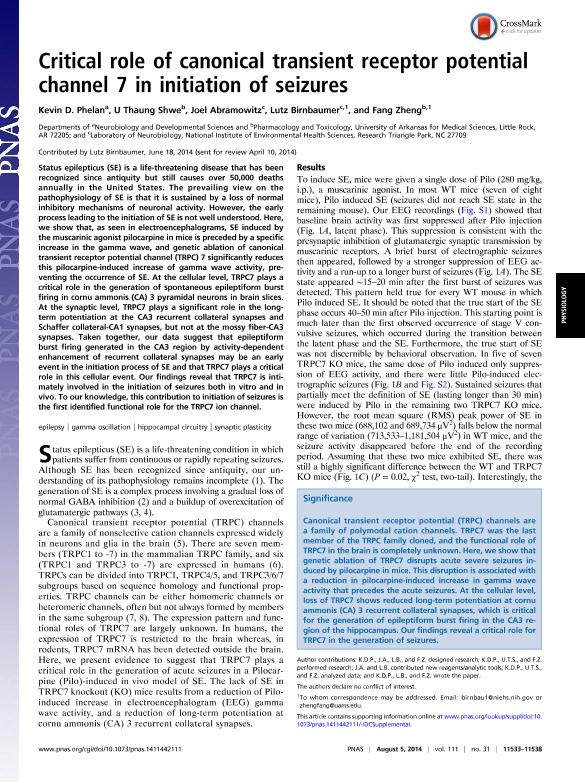Mostrar el registro sencillo del ítem
dc.contributor.author
Phelan, K. D.
dc.contributor.author
Shwe, U. T.
dc.contributor.author
Abramowitz, J.
dc.contributor.author
Birnbaumer, Lutz

dc.contributor.author
Zheng, F.
dc.date.available
2018-04-26T18:35:42Z
dc.date.issued
2014-07
dc.identifier.citation
Phelan, K. D.; Shwe, U. T.; Abramowitz, J.; Birnbaumer, Lutz; Zheng, F.; Critical role of canonical transient receptor potential channel 7 in initiation of seizures; National Academy of Sciences; Proceedings of the National Academy of Sciences of The United States of America; 111; 31; 7-2014; 11533-11538
dc.identifier.issn
0027-8424
dc.identifier.uri
http://hdl.handle.net/11336/43570
dc.description.abstract
Status epilepticus (SE) is a life-threatening disease that has been recognized since antiquity but still causes over 50,000 deaths annually in the United States. The prevailing view on the pathophysiology of SE is that it is sustained by a loss of normal inhibitory mechanisms of neuronal activity. However, the early process leading to the initiation of SE is not well understood. Here, we show that, as seen in electroencephalograms, SE induced by the muscarinic agonist pilocarpine in mice is preceded by a specific increase in the gamma wave, and genetic ablation of canonical transient receptor potential channel (TRPC) 7 significantly reduces this pilocarpine-induced increase of gamma wave activity, preventing the occurrence of SE. At the cellular level, TRPC7 plays a critical role in the generation of spontaneous epileptiform burst firing in cornu ammonis (CA) 3 pyramidal neurons in brain slices. At the synaptic level, TRPC7 plays a significant role in the long-term potentiation at the CA3 recurrent collateral synapses and Schaffer collateral-CA1 synapses, but not at the mossy fiber-CA3 synapses. Taken together, our data suggest that epileptiform burst firing generated in the CA3 region by activity-dependent enhancement of recurrent collateral synapses may be an early event in the initiation process of SE and that TRPC7 plays a critical role in this cellular event. Our findings reveal that TRPC7 is intimately involved in the initiation of seizures both in vitro and in vivo. To our knowledge, this contribution to initiation of seizures is the first identified functional role for the TRPC7 ion channel.
dc.format
application/pdf
dc.language.iso
eng
dc.publisher
National Academy of Sciences

dc.rights
info:eu-repo/semantics/openAccess
dc.rights.uri
https://creativecommons.org/licenses/by-nc-sa/2.5/ar/
dc.subject
Epilepsy
dc.subject
Gamma Oscillation
dc.subject
Hippocampal Circuitry
dc.subject
Synaptic Plasticity
dc.subject.classification
Otras Ciencias Biológicas

dc.subject.classification
Ciencias Biológicas

dc.subject.classification
CIENCIAS NATURALES Y EXACTAS

dc.title
Critical role of canonical transient receptor potential channel 7 in initiation of seizures
dc.type
info:eu-repo/semantics/article
dc.type
info:ar-repo/semantics/artículo
dc.type
info:eu-repo/semantics/publishedVersion
dc.date.updated
2018-02-06T20:08:17Z
dc.journal.volume
111
dc.journal.number
31
dc.journal.pagination
11533-11538
dc.journal.pais
Estados Unidos

dc.journal.ciudad
Washington
dc.description.fil
Fil: Phelan, K. D.. University of Arkansas for Medical Sciences; Estados Unidos
dc.description.fil
Fil: Shwe, U. T.. University of Arkansas for Medical Sciences; Estados Unidos
dc.description.fil
Fil: Abramowitz, J.. National Institute of Environmental Health Sciences; Estados Unidos. Consejo Nacional de Investigaciones Científicas y Técnicas; Argentina
dc.description.fil
Fil: Birnbaumer, Lutz. National Institute of Environmental Health Sciences; Estados Unidos
dc.description.fil
Fil: Zheng, F.. University of Arkansas for Medical Sciences; Estados Unidos
dc.journal.title
Proceedings of the National Academy of Sciences of The United States of America

dc.relation.alternativeid
info:eu-repo/semantics/altIdentifier/doi/http://dx.doi.org/10.1073/pnas.1411442111
dc.relation.alternativeid
info:eu-repo/semantics/altIdentifier/url/http://www.pnas.org/content/111/31/11533
Archivos asociados
